Eder, D., 1980,
Kaukasische Teppiche (and the English edition of the book, Bennett,
I., 1982, Caucasian Carpets, have
for a long time been among the cornerstones to our understanding of 19th and
early 20th century Caucasian rugs. Therefore it is surprising that in the
more recent book by Azadi, S.U., Kerimov, L., and Zollinger, W., 2001, Azerbaidjanisch-Kaukasische
Teppiche, no reference is made to a group identified and described
by Doris Eder, the so called Tachte Shirvan.

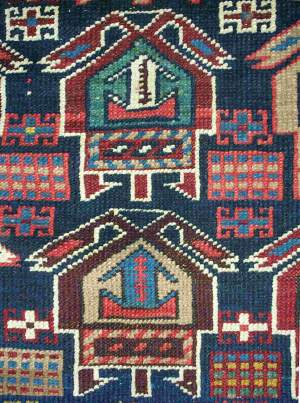
Tachte in Turko-Iranian language means ‘throne’, in a semantic
as well as in a figural sense. For instance, Tacht-i-Sulayman
(throne of Salomon) is a hill in NW Iran 110 km west of Sandschan and
northwest of Bidjar, carrying an excavation site of a once fortified
city from the Sassanian and Mongol periods. The significance of Tachte
Shirvan rugs rests in the peculiar large symbol on those rugs, for Doris
Eder representing an Avar throne. The Avar were probably related to
the Huns and had settled in an area between the lower Danube region
in the west, and the north-eastern shores of the Black Sea. For a hundred
years they appear to have been a military force, giving the early Byzantines
much trouble. Those were the old Avar. There also are the younger Avar,
settling in Daghestan to the present day. On grounds of their language,
to some writers they are probably unrelated to the old Avar (www.wikipedia.org).
The two or three rugs with an Avar label I have come across in recent
years in the trade or in the internet seemed unrelated by design and
left no lasting impression with me.
So, if it is not a younger Avar throne that is depicted on those rugs, might it be an old one? Probably neither. A Google based survey, following up a substantial number of entries on Avar, yielded no results that could be linked to this particular (textile) design (entries followed-up included data on a major Austrian Avar exhibition a few years ago). After this, it is not surprising, that the Avar throne attribution did not find resonance in the mentioned publication by Azadi, et al.
The Avar throne on those rugs very likely is a representation of a Torah Shrine or of the Ark of the Law (also: Ark of Covenant).
Comparing the main motive on the rug on plate 09 with the much older Torah Shrine or Ark images in part I of this salon, it becomes immediately apparent that all the significant elements are shared, i.e. the gabled roof over a pentagonal structure, the box principle, the threefold base or rest; the entrance doors appear as an arrow, expressing the principle of transcendence in a different image language (for a very interesting discussion, among other topics of the symbolic meaning of the "Sky-Door" see Cammann, S.V.R., 1972, Symbolic Meaning in Oriental Rug Patterns I-III, TMJ III/3 pp 5-54).In
the discussion of some of the rugs in the Zollinger collection Azadi,
et al express their wonder on that strange and most peculiar symbol
("Das äußerst eigenartige Fünfeck", Azadi,
S.U., Kerimov, L., Zollinger, W., 2001, a.a.o., p 362) in their high
level technical analyses, but offer no concept. On one occasion they
call it an animal-throne composition ("Tier-Thron-Komposition", a.a.o.
p 332). Unlike Eder, who reserved a group-label for those rugs (Tachte
Shirvan) they simply call the rugs by the name of their geographical
area: i.e. Marasali, a village in the Shirvan area.
(1) This group features a repetition of the Ark of the Law, all else
are decorative additions (plate 09). The arrangement of the arks and
the usage of space, although much less sophisticated, echoes the "Spanish
Synagogue Carpet" in the Islamic Museum in Berlin. In that sense
it is a "key rug" to me. If it had not been for its crisp,
clean drawing that was giving me a deja-vu, perhaps the
likeness to the motive in the Synagogue Carpet would have gone unnoticed.
It is not a common type, the only other one to this group I can think
of passed through auction at Nagel's in Stuttgart in 1981
(lot 173, 291st auction).
(2) One of the two most common types, featuring the Ark, tablets depicting
the ten commandments and figures who according to Azadi, Kerimov &
Zollinger a.a.o. entertain in the group-dance, "Jally". If one has
accepted that the main image is that of the Ark, the Jally-interpretation
becomes unconvincing (as does an interpretation based on the assumption,
those tablets were Muslim tombstones). I know a man who grew up in Baku
and who spent much time in his youth with his grandparents in the Kuba
area, where his grandfather was a rabbi. Now, in an official position,
he is fostering the integration of Jewish immigrants from the territory
of the former Soviet Union into the German ways of life - quite a delicate
task in my opinion. According to him, the Jewish community does not
dance Jally, it being a dance of the Muslim population only.
There is a special significance attached to those figures. If I got it
right, ten men are needed for full prayer according to Jewish
tradition. In most rugs of this type, especially the ones that appear
to be older, ten figures are depicted. As far as Jally is concerned, no
significance is attached to the figure ten.
Also, according to an entry in Encyclopaedia Britannica, once ten Jews
(men) had come together forming a community, a Synagogue had to be
built, a task that may have stretched the means of some - could a woven
synagogue or ark have been an easy way out?
The following rug is from the Doris Eder/Ian Bennett book (plate 11).
It is a splendid example of the type and illustrates the bondage of
those figures to the Ark in a kind of "tilted image" (figure-ground-separation
being the underlying perceptual principle). If you look carefully, you
can identify the shape of the Ark between those figures. Their shape
is determined by the representation of the Ark, which serves as a kind
of "independent variable" in the process.
11 Eder/Bennett 271

And two more recent ones:
12 Eder/Bennett 269

13 Azadi, et al 086
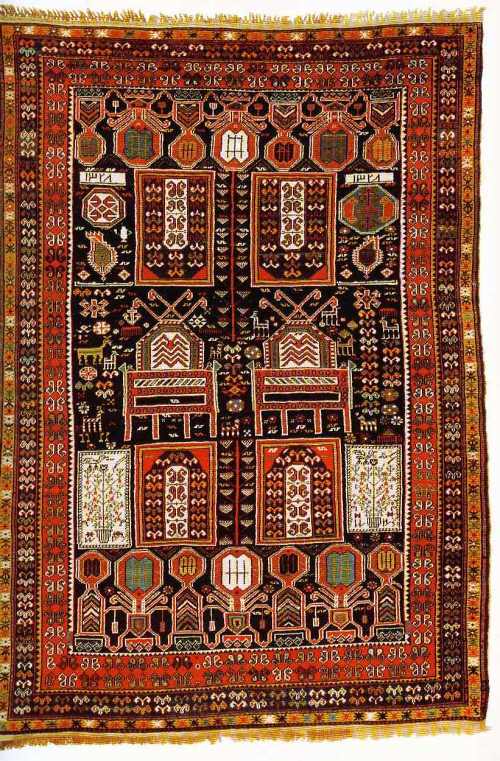
(3)
This group is characterised by a very unusual integration of Muslim
and Jewish religious representations, the Ark under the gable
of a prayer rug:
14 Eder/Bennett 326
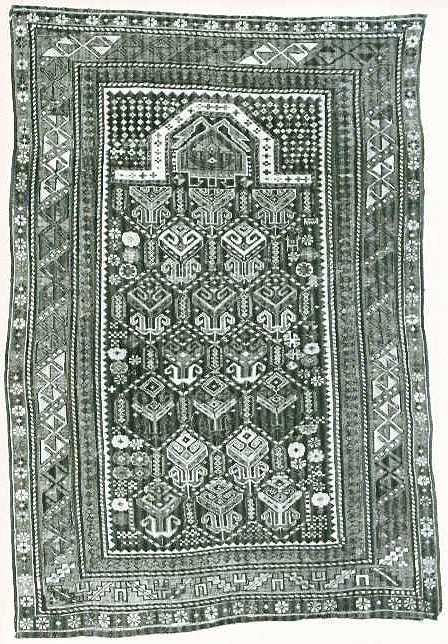
15 Eder/Bennett 327
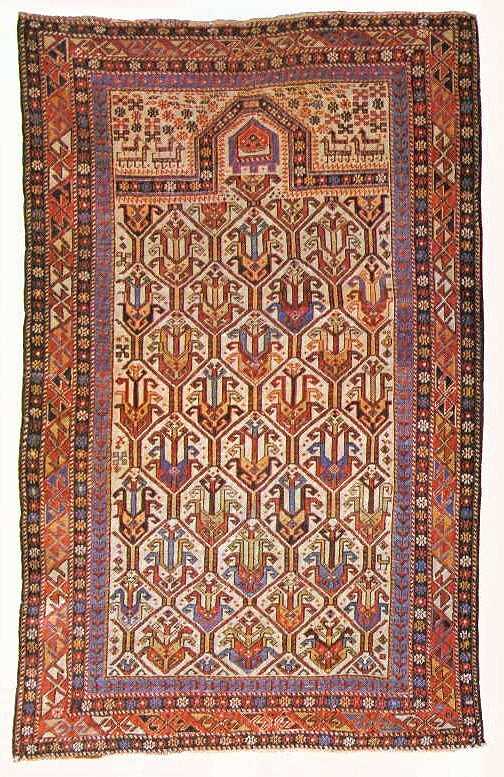
16 Azadi et al 038

17 Azadi,
et al 077

18
Azadi et al 101

As to the origin of this type or the question, what may have prompted
this integration, nothing has been heard or published (see further down
for a discussion).
(4) Rugs of this type (plate 19) are also uncommon I believe, the one
presented by Austin Doyle at the Keshishians's party and introduced
to us by John Howe on Turkotek in January this year is the only one
I have seen so far. The Ark seems to have been left out along with the
tablets, only iconographic representations of human figures remain (see
type 2). Only if one knows what one is looking for, in between individual
figures the shape of the ark can be made out.
19
HM3
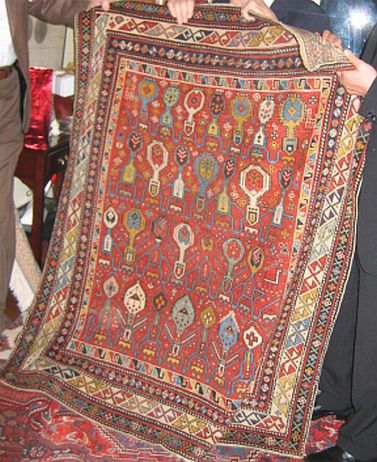
There were later incursions and persecutions by Christian-Orthodox powers before and after the "Russification" of the region that may have prompted Jews to look for shelter under the umbrella of Islam. An old formula of survival in the Diaspora comes to my mind: "Where you can't get over something, you may always try to get under" (Singer, I.B., 1977, A Crown of Feathers and Other Stories. Penguin, Harmondsworth, England).
(2) Besides the Ark, all four groups of rugs share design and technical characteristics of other rugs in the Shirvan-Kuba-Daghestan and Karabagh regions. This seems to coincide with the (earlier) distribution of the Jewish population. Also, quite a few Kurdish communities exist, Kyurdamir in the Shirvan area (Marasali not being far off) being a district capital. The Kurds, being amongst the most prolific weavers wherever they settle, may be responsible for these rugs; some of them may be or may have been Jewish at the time those rugs were made, or long before. In any case, there is a lively Jewish community in Kyurdamir.
According to a dealer from Tabris in Iran, there, rugs of the type as shown in plate 09 he claims, are called "Kurd Kasak". It makes one wonder.
(3)We have all learned at some time or other that "more sophisticated" designs were handed down from court to village and tribe; an assumption that may be right as often as it is wrong. However, if one wants to look out for a court that could be given the credit, there was the Khanate of Khazar. The Khazar settled from around 600 AD on north of the Black Sea and the Caspian, later expanding and becoming the major force in the area, a buffer state between Christian Orthodox powers and expanding Islam, collecting tributes from most of the Caucasus. Those people were Turks, they were Jews and had put up an oasis of civilisation. One of their rulers, Joseph, was in correspondence with an high ranking Jewish official at the Moorish throne in Spain, serving two subsequent califs, Abd-al-Rahman III (912-961) and his son Hakam II (961-976). The correspondence survived: The Letter of Rabbi Hasdai, Son of Isaac Ibn Shaprut, to the King of the Khazars (http://www.fordham.edu/halsall/source/khazars1.html).
We do not know which exact route the letter went. But most likely it would have travelled on the ancient route that has seen much traffic in the course of the millennium before, the northern branch of the silk-route, crossing the Caucasus at the Pass of Dariel - Pompey once left a garrison there (Stark, F., 1966, Rome on the Euphrates, John Murray, London) - reaching for the Pontic at Trapezunt. Where letters could travel, there may also have been space for gifts, for rugs and perhaps drafts or blueprints of designs in decorative arts?
Eventually, the Khanate was overrun by Djinghis Khan, and its people dispersed over a wide area. According to Fenton, A., 1997, Jewish Carpets, some settled in the western Trans-Caucasus. The way down along the Caspian shore and across the Albanian or Derbend Pass (Albania was the name of this country at the times of the Romans) to the eastern Trans-Caucasus would have been easier. Anyway, once across the pass, below the Khazar refugees would have spread the valleys of the Phasis and the Cyrus rivers, linking the Black Sea and the Caspian Sea. In Roman times it would have been a four days journey on a paved road, according to Freya Stark. If they travelled east via Tiflis, as some undoubtedly would have done, down the Cyrus (Kura) and Araxes (Aras) rivers, they probably would have met others Jews already settling there, and still others to arrive at a later time.
The gathering and cohabitation of those groups, some of them Kurdish, Armenia just behind the next range of mountains, would have created - and indeed it has created - an ideal breeding ground for rug production, a kind of "Silicon Valley" for rug technology. All requirements needed were at hand, good sheep, water, plants and minerals for dyes, famous already in Roman times.
(4) When the Spanish Jews (and Muslims) were forced to exit Spain by Royal Decree in 1492, many took up the Sultan's offer to choose Ottoman Turkey as a safe haven. Others settled in Kashan, Persia, where they inspired arts, philosophy, science and medicine (Azadi, S., by word of mouth). Whilst the Caucasus at this time was not exactly part of the Ottoman empire, the Ottomans were the most influential if not controlling power in the eastern Trans-Caucasus. Jews had already been settling in that area for centuries and it seems likely, that some of the Sephardim refugees should have joint them there, bringing with them their own skill and knowledge.
(5) In view of those hypotheses it seems likely, that the rugs were not actually made by just one group. A fair amount of exchange must have existed, this including Muslim neighbours, with whom relations were by and large on the relaxed side, sometimes even cordial. Is it thinkable, that Jews have adopted the idea of prayer rugs from their neighbours, the Ark under the gable oriented towards Jerusalem?
Sometimes rugs with the ark come from somewhat further afar. Lot 164 at a Nagel auction on 16th May 1981 may be counted among those - a Fachralo Kasak:
20 291st Nagel auction lot 164
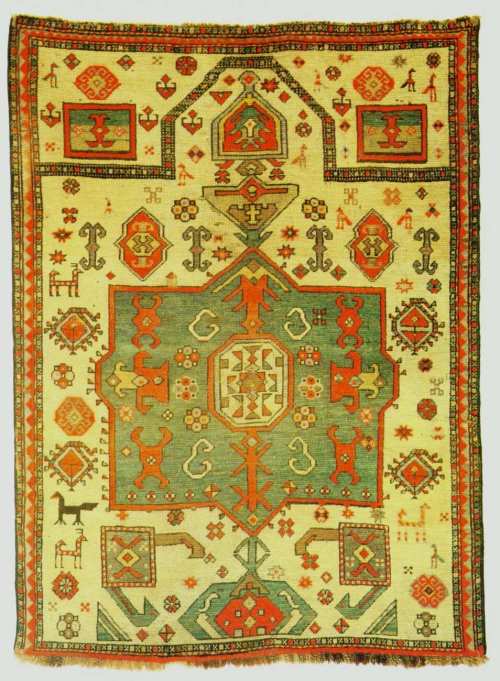
The Eder/Bennett book includes several prayer rugs of the kind in group
three from the Karabagh region (plates 106, 109,110):
21
Eder/Bennett 110
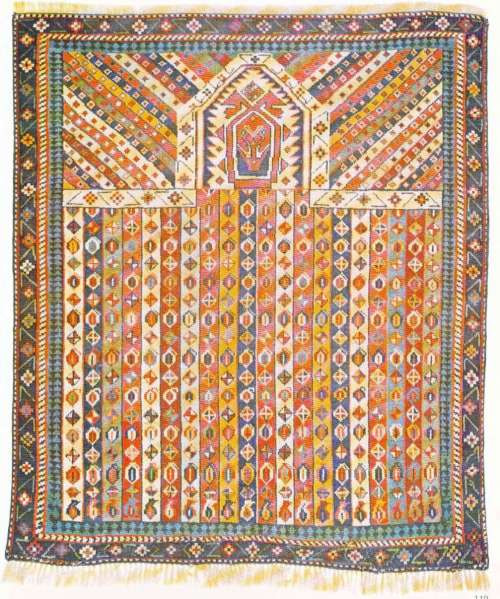
Another rug from somewhat further afield would be plate 58 in Jewish Carpets - a dated Jewish Sarab Runner. Looking very carefully at the content of the white medallions, most apparent in the lower half of the third medallion from bottom, the shape of the ark appears in yet a different form but clearly related to what we have looked at before.
22
Detail of Fenton 058
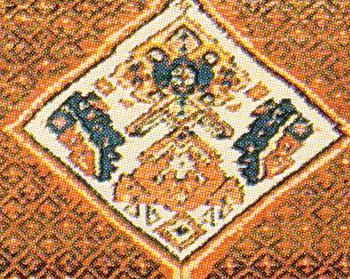
Earlier
this year in Istanbul I had a look into a rug dealer's library whilst
visiting his shop. Having to deflect his enticements aimed at making
me buy a silk-wefted Shasavan cicim, I was somewhat distracted and forgot
the title of an old book that I thought interesting. In it was the picture
of a rug with the Ark as the main motive in the style of a Sarköy
kelim with curvilinear wefts. It was attributed to "Bessarabia".
We are coming to the end. Not all is lost, the woven Ark has been restored
to memory. Some riddles remain, but we know better now what we are dealing
with, field-research seems desirable.
Somewhat disturbing news reach my ear, of nuclear ambitions of a neighbour
state, of military build-up and strategic airfield expansion in Kjurdamir,
on the Aspheron peninsula and elsewhere, Azerbaidjan, the old buffer-state
in the thick of it, anxious to define its role. It is not an easy time
for the region. Was it ever?
The Kingston Trio is seldom heard on the radio these days. I might as
well turn it off here and hope, it is going to be another good year,
after all.